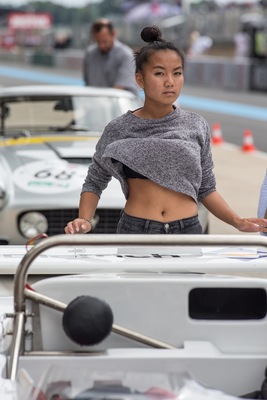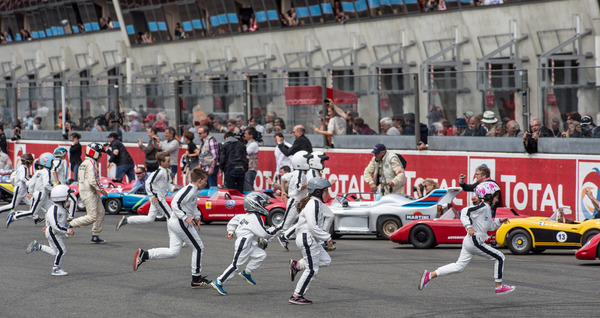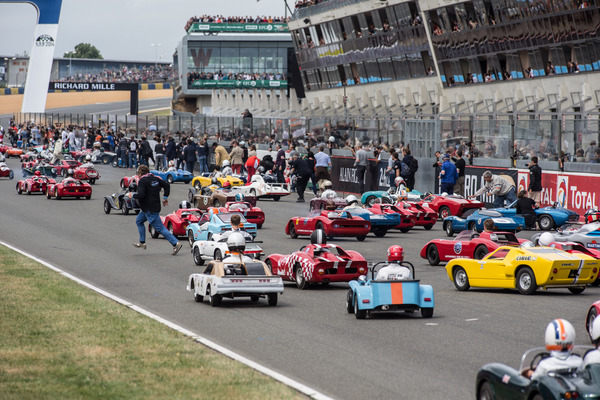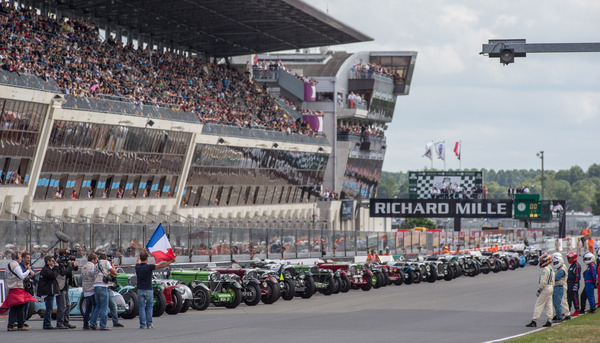Together with the Monaco GP and the Indianapolis 500, the 24 Hours of Le Mans is probably the most important and traditional car race in the world. In addition to the "normal" 24 hours, the "classic" 24-hour race also takes place every two years.
The approximately 400 to 500 - in 2014 there were 456 - vehicles are divided into six starting fields, which are organized according to age groups, and sent on their way alternately over 45 minutes. This means that each field drives a race of around 2 hours and 45 minutes with three starts.
Under all conditions
Le Mans is not just about driving day and night, but also about driving in the wet and in the dry, in wind and rain or in heat and sunshine.

On the weekend of July 5 and 6, 2014, the weather in the Sartre was like that normally found in Iceland. You never knew what the weather would be like. If you opted for slicks, you had to change wheels after ten minutes, or vice versa.
Some wanted sun and dry conditions, while others preferred cooler temperatures and perhaps even wet conditions for better cooling, such as Christian Traber in the pre-war field with the Talbot Lago, which won the 2013 Klausen race.
Show elements
The traditional Le Mans starts were staged as a pure show for the oldest three starting fields (cars built before the seat belt requirement).

Just over an hour earlier, around 100 children demonstrated this procedure to the drivers. They also lined up opposite the vehicles and ran off. First, they unintentionally demonstrated a classic false start, which led to a restart. Then everything went smoothly.

Even the drivers were so impressed by the children that one or two of them happily recorded the demonstration on their cell phones.
Pure racing action
On Saturday, Sebastien Loeb gave the go-ahead with the French flag at 5 p.m. sharp, watched closely by FIA boss Jean Todt.

All 76 drivers ran to their cars and off they went. Now it was 24 hours of thoroughbred racing action.
110,000 enthusiastic spectators lined the edge of the track and witnessed cars from 1925 to 1979.
Fierce duels
Even in the pre-war class, there was a fierce duel between the two Talbots of Traber and Birch-Burnett. While Christian Traber was able to win the first race after his opponent made a mistake in the first chicane, Birch-Burnett countered in their favor in the next two races.
Superior Jaguar
Groups 2 and 3 were dominated by Jaguar. Plateau 2 (1949-1956) was won by the C-Type of Finburgh-Newall ahead of the Austin Healey of Thorne-Bennett-Baggs and Plateau 3 (1957-1961) went to the D-Type of Pearson-Harris ahead of the Ferrari 250 GT Berlinetta of Gaye.
The series of pictures of Chris Ward's Jaguar XK 120 shows how quickly fun can turn into bitter seriousness. A driving error by the Englishman caused the rear end of the cat to break away and it was only with a lot of luck that a normally harmless spin did not result in a rollover.
This year, the track was given new curbs, especially in the two chicanes before the start and finish, and thus high barriers, which could also mutate into brutal vehicle killers. Yannick Dalmas, one of the people responsible for these curbs, said: "The good drivers love them, the "less" good ones hate them. They demand a clean, rounded driving style. Flying over them is immediately punished with a damaged vehicle.
Driving in convoy
Many safety car phases characterized the races of the youngest vehicle group in particular. The sports cars of the seventies were often unable to complete more than three or four free laps. There was always something going on. There were heavy crashes, and then suddenly heavy rain prevented the cars from setting a racing pace.
Jochen Mass: "You can't see much anyway, but your colleagues are also driving behind the safety car with full war lights and illuminate your cockpit fivefold".
Despite the very short race distance, there were of course winners here too: Mac Allister in the Gulf Mirage was clearly the fastest ahead of Barbot in the Lola T280.
Group 5 was won by Hart's Lola T70 MK lll and Group 4 by Hugenholtz's Ford GT40.
For the fun of it
There are always winners, but despite ambition and racing fever, the participants in the Le Mans Classic are all about having fun. They wanted to have fun and they certainly did. The drivers in their flying cars, but also the numerous spectators at the side of the track with umbrellas and caps.
The fans applauded frenetically at every wild drift or spin. They were fascinated by the different engine concepts, which massaged their eardrums with cultivated rhythms like Beethoven or with a hard beat like AC/DC.
The spectators' eyes could not only feast on the different shapes but also on the different driving styles. Whether understeering or oversteering, drifting on three or even just two wheels, everything was on offer here. A Bugatti 35 suddenly gained grip after a wild drift, lifting one side of the vehicle high into the air. The fans showed their great enthusiasm for the acrobat with loud shouts on each subsequent lap.
Despite the rain, there was also plenty for the nose to sniff. Oils of all kinds, with and without additives, were burned by the liter.
Lots of celebrities
Many well-known names from the motorsport scene were also present: from Sebastien Loeb to Jochen Mass, from Jean Ragnotti to Jürgen Barth, from Prince Leopold of Bavaria to Yannick Dallas, from Johnny Cecotto to and with Jean Belmondo.
They all enjoy coming back to the Sarthe.
Two-year break
It will now be 730 days until the classic 24 Hours starts again in 2016. A race with so much history and tradition, laden with emotion, is an event that you simply have to be part of, both modern and classic.
The only objections from a visitor's point of view concerned the traffic concept on the one hand and concerns about food and drink on the other.
The access road was so chaotic that most of those arriving with historic carriages had to use the emergency lane. Whether they made it to the grandstand in time for the start is doubtful. And as for the stalls with the culinary delicacies, well, they really don't even deserve a Michelin star.






















































































































































































































































